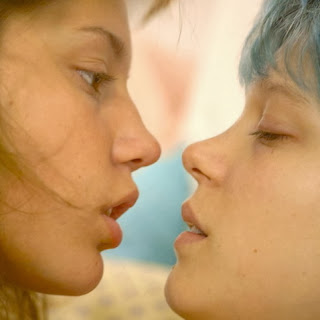Originally published in The Daily Nebraskan, 11/15/2013
Adèle is pressured by her catty friends into dating a boy she doesn’t really like. She has sex with him, and the scene we see is graphic and depressingly empty. After she breaks up with him, she starts crying and shoves a candy bar in her mouth to console herself. The very first shot of the film is Adèle running toward the bus, but then it drives away without seeing her. The movie really picks up once Adèle meets Emma. Most of the running time is devoted to their intense romance and sexual exploration.
The film is structured in a way that implies the emotional growth Adèle will experience as we follow her story. The screen is always filled with faces, so close to us that we feel like we can just reach out and touch them. The soundtrack is riddled with wet, smacking noises as we watch characters eat meal after meal. The same kinds of sounds are heard as Adèle and Emma kiss. The sounds are sometimes uncomfortably intimate, and they reminded me that love is not always pretty and clean. Love can be dirty and leaves one vulnerable to pain. When you are in love, the world falls away, and nothing else matters.
Director Abdellatif Kechiche must have said something along those lines to his cinematographer, who filmed the movie as a series of intimate close-ups with backgrounds out of focus. We don’t really feel the need to know anything about why Adèle is the way she is; why she hangs out with her petty friends or any details about her relationship with her parents. All that matters is that she felt emptiness — then she found Emma. There is even one scene in which the two of them are so overcome with tenderness and passion for one another that they begin to grope each other loudly in the middle of a café. There are other people around, but we are not given reaction shots of those people, because who cares what they think?
By the time we reach the controversial eight-minute sex scene, we may not understand why it’s there. I think the scene is as long as it is because it contrasts the routine emptiness of the earlier, briefer scene with Adèle and her male classmate. This scene feels more alive and meaningful. Adèle is here because she wants to be and not because she is pressured by her peers. Both actresses, Exarchopoulos and Seydoux, were brave not only because of the skin they bared for their roles, but the depth of emotion and pain they brought to their characters.
The film is not without its flaws. There’s the ever-present shaky cam that I feel is the bane of modern cinema (somebody get these cinematographers some Dramamine). The sex scenes may feel gratuitous to some viewers, and they could be right. There have been complaints of a male perspective in the scenes of female-on-female sexual intimacy. Because this was directed by a man, that criticism isn’t far-reaching.
I also think it could be shorter, but I don’t know what could be cut out. Kechiche spends a lot of time with quiet shots of walking, sitting, reading, etc. There is an interesting rhythm going for this movie, and I think cutting it down would diminish its impact. I walked out of the film not with a neatly wrapped up story on my mind, but with an impression of what the characters felt in the time I spent with them. It’s not a movie for everyone, but for anyone who wants to see an unsentimental love story like few ever depicted in the cinema, I highly recommend it.


